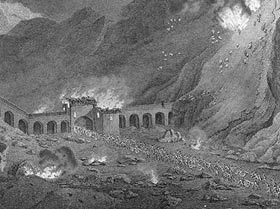Siege of Fort Bard facts for kids
Quick facts for kids Siege of Fort Bard |
|||||||
|---|---|---|---|---|---|---|---|
| Part of the Italian campaigns in the War of the Second Coalition | |||||||
 Piedmontese cannons shooting at the French |
|||||||
|
|||||||
| Belligerents | |||||||
| Commanders and leaders | |||||||
| Strength | |||||||
| French advance guard | 400 men | ||||||
| Casualties and losses | |||||||
| Unknown | 200 dead or wounded 200 captured |
||||||
The Siege of Fort Bard was an important military event in May 1800. It happened during Napoleon Bonaparte's second campaign in Italy. This battle stopped Napoleon's army for 12 days at a narrow mountain pass. Fort Bard was a strong fortress. It was defended by about 400 soldiers from Austria and Piedmont. Their commander was Captain Josef Stockard von Bernkopf.
Contents
Why Was Fort Bard Important?
On May 13, Napoleon and his army entered the Aosta Valley in Italy. They came from a small town in Switzerland called Bourg-Saint-Pierre. For a few days, the French army did not meet any enemy soldiers. But as they got closer to Aosta, they had small fights with the Austrian army.
Napoleon's plan was to surprise the enemy. He wanted to move his army quickly through the mountains. Fort Bard stood in his way. It was a small but very strong fort.
The Fort's Location
Fort Bard was built on a tall rock. It controlled the main roads through the valley. This meant Napoleon's large army could not easily pass. There was only a small mule path around the fort. Napoleon's first soldiers used this path to go ahead to Ivrea.
The Siege Begins
On the evening of May 20, French generals Dupont and Dufour reached the village of Bard. This village was right below the fort. General Dupont asked Captain Bernkopf to surrender, but Bernkopf refused.
Meanwhile, French engineers worked hard. They made the mule path wider and smoother. This allowed most of Napoleon's army to continue moving. However, their heavy cannons could not pass yet.
Taking the Village
On the night of May 21, the French army attacked. They took control of the village of Bard. This allowed them to surround the fort. The next day, on May 22, the French started firing cannons at the fort. These cannons were captured from the Austrians earlier. But they were too small to do much damage to the strong fort walls.
A Fierce Fight
The defenders of Fort Bard fought bravely. On May 26, about 300 French soldiers called grenadiers attacked the fort. Their goal was to distract the defenders. This would allow a smaller French group to cross the Dora river nearby.
The fight was very tough. The fort's defenders killed or wounded more than 200 of the French grenadiers. General Dufour also died trying to cross the river on a raft. Napoleon himself was worried. The fort's resistance was much stronger than he expected. He also knew another enemy army was coming from Piedmont.
Napoleon's Next Move
On May 27, Napoleon made a decision. He ordered a division of his army, led by General Joseph Chabran, to stay and besiege the fort. Napoleon then continued with the rest of his army. He rejoined his advance guard, who had already passed the fort.
A group of 1,243 French riflemen, led by 119 officers, kept attacking the fort. But their hidden cannons were still too small to cause serious damage.
The "Andreossi" Cannon
The siege continued until May 29. Then, the French brought in a very large cannon. It was a 12-inch cannon named "cannone di Andreossi" (Andreossi's cannon). They placed it in a church behind the fort. This spot was perfect because the fort's defenders could not see it.
On June 1, the "Andreossi" cannon began to fire. Its powerful shots started to destroy parts of the fort's walls. By the end of the day, Captain Bernkopf knew he could not hold out any longer. He had lost half of his soldiers. He decided to surrender.
As was the custom back then, the Italian soldiers were allowed to leave the fort with "honours of war." This meant they could march out with their flags and weapons. After leaving, they became prisoners of war.
What Happened After the Siege?
Napoleon called Fort Bard a "vilain castel de Bard," which means "evil castle of Bard." He ordered the fort to be completely destroyed. It was not rebuilt until 1830 by Charles Albert of Savoy.
The siege of Fort Bard caused a delay for Napoleon's army. His plan was to surprise the Austrian and Piedmontese forces on the Po river in Lombardy. The 12-day delay meant his surprise attack was not as effective. However, Napoleon still managed to take over Piedmont and Lombardy. He defeated the Austrians in the important Battle of Marengo.
See also
 In Spanish: Sitio del Fuerte de Bard para niños
In Spanish: Sitio del Fuerte de Bard para niños
- War of the Second Coalition
- Napoleonic Italian Campaigns

